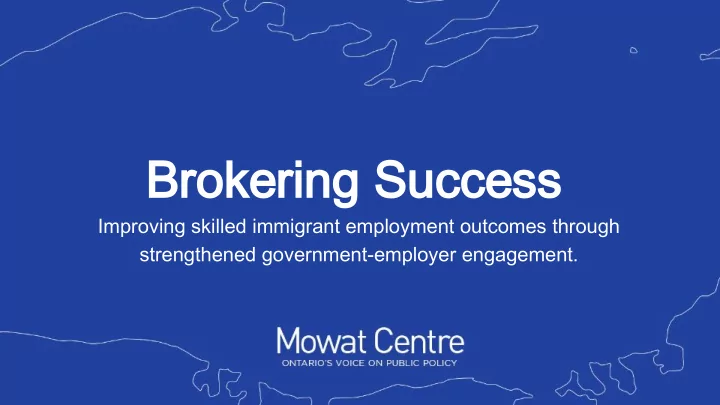

Brokering Success Improving skilled immigrant employment outcomes through strengthened government-employer engagement.
Agenda Speakers Matthew Mendelsohn, Director, Mowat Centre Ratna Omidvar, Executive Director, Global Diversity Exchange (GDX), Ryerson University Moderator Joan Andrew, Public Servant in Residence at Ryerson University Question and Answer Period 2
Today’s presentation Matthew Mendelsohn, Director, Mowat Centre FINDINGS OF THE STUDY Ratna Omidvar, Executive Director, Global Diversity Exchange (GDX), Ted Rogers School of Management, Ryerson University RECOMMENDATIONS AND THE PATH FORWARD 3
At an estimated price tag of $11.37 billion per year in unrealized earnings, we can ill- afford to continue discounting the qualifications and experience of immigrants to Canada. 4
The study How do governments engage with employers on the issue of employing skilled immigrants? What tools do governments have at their disposal to improve this engagement and its outcomes? 80 interviews, across 10 provinces, with governments, employers, not-for-profits and immigrant employment councils. 5
Framing the Landscape 6
Framing the Landscape Skilled recent immigrants have an unemployment rate four times that of Canadian-born peers. The income and employment gap is getting harder to overcome. Since 2008, Labour Market Agreements have fostered a more demand-led approach to supports. Upcoming Express Entry and Canada Job Grants depend on employer leadership. Want to make sure small and medium employers aren’t 7 left out of the conversation.
Levers for government- employer engagement 8
Legislation and Policy Economic Development Offices Funding Employment and Settlement Services Intermediaries 9
Legislation and policy Immigration entry streams Equity legislation, protection for workers PNP, TFW, Experience class Employers are seeking speed Equity works, though not for and local market fit, more than everyone; hard to expand. lower wages or security. Manitoba’s WRAPA model: employers must engage through licensing, but receive extra services . 10
Economic development offices and employer outreach Economic development officers have one-on-one contact with employers. These officers can be first point of contact for programs, requirements, supports. Economic development work is often regarded as separate from employment and workforce planning. Exception: Alliés Montréal, an Immigrant Employment Council, is co-located with a regional 11 economic development agency.
Funding of employment and settlement services “Classic” funding of job-readiness, work-placement programs via not-for-profit sector (wage subsidy, etc.). Governments looking for greater funding leverage: Instability and constant change a problem. • B.C. Employer Innovation Fund • Employers are interested in settlement and integration as • employment benefit. Marketing settlement services at subsidized rates to business. • 12
Intermediaries A major area of connection: Advantages include: Sector-specific knowledge, Sector Councils • • labour market info Professional and Industry • A consistent network of Associations • employers over time Business Councils, Boards of • Trade, IECs Searching for a sustainable funding model 13
What’s working elsewhere? U.S.: Michigan Works!, WIRE-Net • U.K.: Sector Skills Councils • AUS: Enterprise Migration Agreements • NZ: Skills and Employment Hubs • Many ways to approach combination of government, employers and community organizations. 14
Principles for Action 15
Adapt to local needs Recognize Canada’s regionally-segmented labour market Culture matters, too: Equity in Quebec versus Ontario Provinces small and large: make employer engagement as direct as possible Economic development officers where feasible • Otherwise, intermediaries such as sector councils • Incent employers to develop their own solutions 16
Support smaller enterprises Engaging large employers can become the path of least resistance. Important to include a strategy for SMEs early in the development of new programs. Combine levers: for example, intermediaries helping SMEs access funded supports. Governments should aim to benefit those who do engage with greater efficiency: WRAPA regulatory 17 obligation leads to talent solutions.
Build a common language Seek intermediaries, such as business organizations and economic development officers, who speak the language of business. Encourage employers to more concretely define skills and qualifications to get past the “Canadian experience” barrier. Competency-based language can also improve labour market information. 18
Promote stability Keeping up with frequent, disruptive policy changes can cause employer disengagement. Anxieties around the shape of the Canada Jobs Grant are an example of this. Long-term stability of program branding, design is key to developing relationships of trust. Should fix things that don’t work, but if something is working, keep doing it! 19
Recommendations 20
• Develop clear strategies for engaging employers “Internal” Recommendations • Use an integrated, whole-of government approach • Undertake more rigorous analyses of the R- O - L of these programs • Implement rigorous, harmonized metrics for evaluation • Support more avenues for recruiting skilled labour within Canada 21
“External” Recommendations • pass legislation implementing a recruiter licensing and employer registration system • work together to develop locally-based labour market information • create incentives for employers to move toward competency- based hiring practices • pilot programs to create incentives for ongoing employer engagement with government • develop mechanisms or channels so that employers can provide feedback directly to government 22
Going Forward 1. Jurisdiction is an issue 2. Consultation fatigue among employers 3. Over-representation of selection issues in the policy narrative 4. Lack of stability of programs and policies that support employers 5. Employer engagement is always difficult 23
Question and Answer Period Please type your questions in the question box in the centre of your screen. 24
Wrap-up • Recording will be available shortly • Visit www.hireimmigrants.ca to access success stories, sign up for etips and watch past webinars • Feedback survey 25
Thank you Stay Connected
Recommend
More recommend